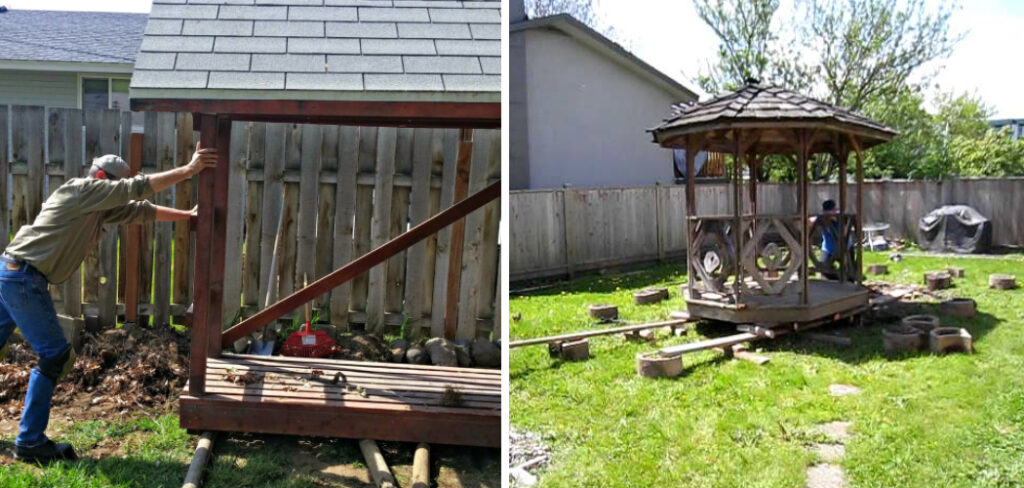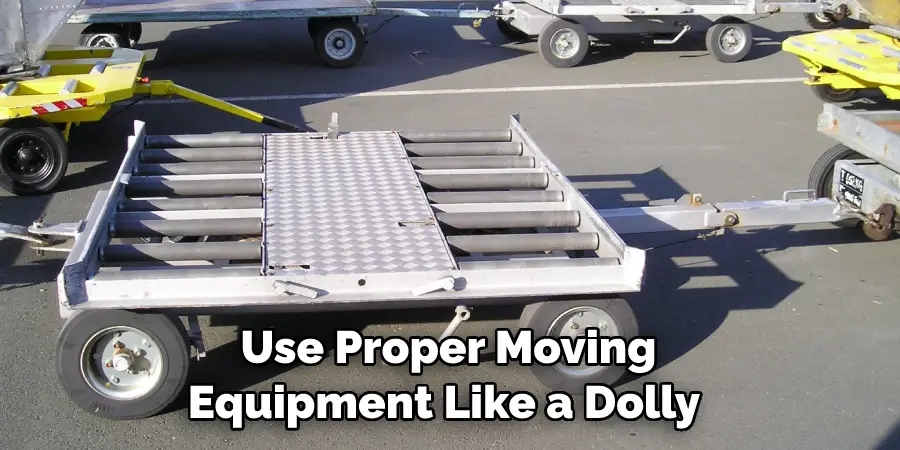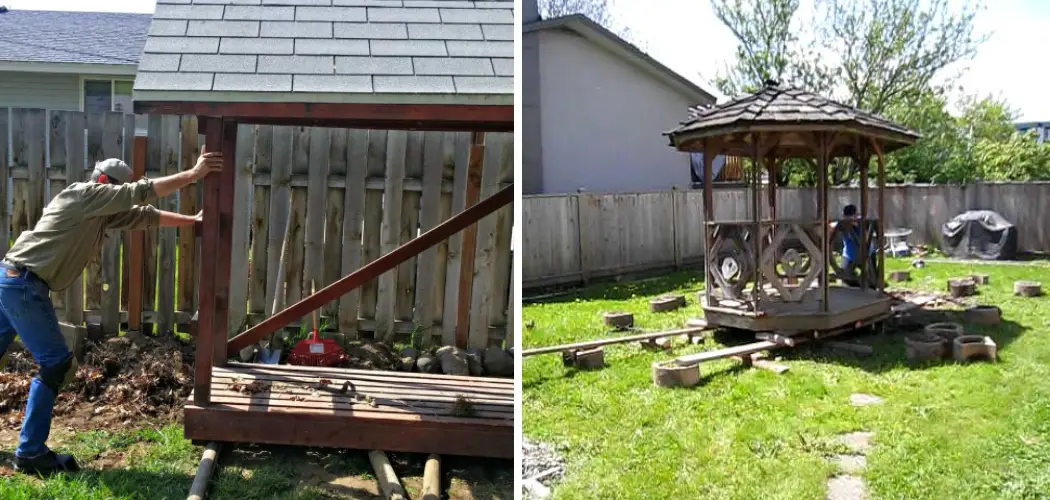Moving a gazebo can seem like a daunting task, requiring careful planning and execution to ensure its safe relocation. Whether you’re looking to enhance your outdoor space’s aesthetics or simply seeking a change of scenery, understanding the intricacies of moving a gazebo is essential.

From dismantling and preparing the structure to selecting the right
equipment and enlisting helping hands, this process demands a methodical approach. Factors such as gazebo size, material, and the distance it needs to be moved all play crucial roles in determining the complexity of the undertaking.
In this guide, we will delve into the step-by-step process of how to move a gazebo, offering valuable insights into disassembly techniques, equipment requirements, and strategies to the entire endeavor. By the end, you’ll be equipped with the knowledge needed to ensure a successful gazebo relocation, allowing you to bask in the beauty of your outdoor haven in its new, carefully chosen location.
What Is a Gazebo?
A gazebo is a free-standing, open-sided structure that is usually octagonal or hexagonal in shape. It can be used as a gathering area for visitors to your home or yard, or even as an outdoor dining area.
Although most gazebos are made of wood, some can also be constructed from metal or other materials. Regardless of the material used for construction, all gazebos should be handled with care when being moved.
Importance of Planning and Careful Execution when Moving a Gazebo
Moving a gazebo is not a task that should be taken lightly as it can cause serious damage, if done incorrectly. When planning to move a gazebo, consider the following steps:
- Decide on the new location and plan out how you will get the gazebo there safely and securely.
- If moving by yourself, make sure you have help to assist in the process.
- Disassemble as many parts of the gazebo as possible to reduce its size and weight. This will also help protect any fragile components from damage during transport.
- When transporting the gazebo, make sure it is secured tightly with rope or bungee cords.
- Once the gazebo is at its new location, reassemble it carefully. Take your time and ensure each part is connected securely before moving on to the next step.
- If necessary, use a leveler to make sure the gazebo is even and balanced when erecting it.
- Lastly, make sure all safety guidelines are followed, such as keeping the gazebo away from overhead power lines or other hazardous structures.

By following these steps and taking extra care when moving a gazebo, you can ensure its safe transit to its new home. Additionally, it is important to remember that if any component of the gazebo needs repair or replacement, the job should be done by a professional. This will help keep the gazebo in good condition and ensure its longevity for years to come.
10 Methods How to Move a Gazebo
Method 1: Holistic Assessment and Analysis
The journey of moving a gazebo commences with a thorough assessment of the structure itself. Scrutinize its dimensions, material composition, and structural integrity. Ascertain whether the gazebo can be disassembled or if a whole-unit relocation is more feasible.
Furthermore, evaluate the existing and potential new locations, taking into account factors such as sunlight exposure, landscape integration, and accessibility.
Method 2: Acquisition of Requisite Tools and Equipment
Equipping yourself with the appropriate tools and equipment forms the backbone of a successful gazebo relocation. Collate an arsenal of tools ranging from basic hand tools such as screwdrivers, wrenches, and hammers to specialized gear like cranes or forklifts, depending on the complexity of the project.
Tarpaulins, ropes, leveling devices, and protective gear for the workforce are also integral components to ensure a seamless move.
Method 3: Crafting a Meticulous Blueprint
Moving a gazebo demands a meticulously orchestrated plan, akin to a choreographed symphony. Draft a comprehensive blueprint that outlines every intricate detail of the relocation process.
Plot the precise route the gazebo will traverse during transport, factoring in obstacles, terrain variations, and spatial constraints. Take measurements of doorways, gates, and passages to guarantee that the gazebo components can navigate through unhindered.
Method 4: Deconstruction with Precision
Should the gazebo’s design permit, embark on the deconstruction phase with utmost precision. Begin by delicately dismantling the roof, followed by the walls, flooring, and other components. Label each part meticulously to facilitate seamless reassembly. Secure all screws, bolts, and small fittings in clearly labeled bags to avert any confusion during the reconstruction stage.

Method 5: Priming the Foundation
Prepare the new foundation or site where the gazebo is destined to stand. The significance of a level and robust foundation cannot be overstated. Depending on the gazebo’s size and design, this may entail pouring a fresh concrete foundation or reinforcing an existing one. Attaining a stable base is crucial to guarantee the gazebo’s longevity and structural integrity.
Method 6: Methodical Transport of Components
The logistics of transporting gazebo components demand meticulous planning. Choose an appropriate mode of transportation and ensure the components are securely fastened to prevent damage during transit. If the gazebo’s magnitude surpasses human capacity, engaging professionals proficient in relocating sizable structures may be prudent.
Method 7: Reassembly as an Art Form
As the gazebo reaches its new abode, commence the reassembly process like an artist meticulously crafting a masterpiece. Begin with the roof, ensuring precise alignment and stability. Progress to the walls and any embellishments, meticulously adhering to the assembly instructions and employing your labeled components. Regularly assess alignment and adjust as needed, guaranteeing a harmonious fusion of form and function.
Method 8: The Crown Jewel – Roof Restoration
Should the gazebo be transported as a complete entity, the focus shifts to securing the roof – the crown jewel of the structure. Affix it securely, employing the appropriate fasteners and techniques to safeguard against the vagaries of nature. Bolster the roofing system’s durability, safeguarding it against adverse weather conditions and the passage of time.
Method 9: Embellishments and the Final Flourish
The relocation journey nears its conclusion with the incorporation of embellishments and finishing touches. Apply paint, varnish, or sealant to shield the gazebo from the elements and enhance its aesthetic allure.
Scrutinize every nook and cranny, rectifying any loose screws or bolts. Consider landscaping around the gazebo to seamlessly integrate it into its new environment, amplifying the visual appeal.

Method 10: The Sanctity of Safety
Throughout this elaborate process, the sanctity of safety remains paramount. Prioritize the well-being of all individuals involved by adhering to proper lifting techniques, employing protective gear, and fostering a culture of vigilance. Exercise caution around potential hazards such as overhead obstacles and fluctuations in the gazebo’s stability.
Things to Consider When Moving a Gazebo
Moving a gazebo can be quite a difficult task, especially if the structure is large or heavy. Before getting started, it’s important to consider the following points:
- Make Sure You Have Help: Moving a gazebo will require at least two people, so enlisting some extra help from friends and family is highly recommended for safety and efficiency.
- Measure the Gazebo: Depending on its size, you may need to ensure that it will fit through any doors or gates at your new location. A tape measure would be handy for this task.
- Take Apart Any Accessories: If there are any accessories attached to the gazebo, such as lights or benches, make sure to take them off and safely store them away before moving the structure.
- Invest in Moving Blankets: To ensure that your gazebo is protected during its move, invest in some thick moving blankets or pads which can help protect it from scratches or other damage.
Some Common Mistakes When Moving a Gazebo
Moving a gazebo can be an intimidating task, but if you plan ahead and use the correct tools it is possible. Here are some common mistakes to avoid when moving a gazebo:
- Not Checking for Hazardous Terrain – Make sure to check the ground in front of and behind the gazebo for any obstacles that could damage the gazebo or pose a safety hazard. Uneven surfaces, sharp stones and other obstacles should be cleared before moving the gazebo.
- Not Planning Ahead – Before attempting to move the gazebo make sure you know exactly where it is going, as well as any pathways that may need to be cleared in order for it to fit. Have a plan of action in place that includes the steps you need to take and people you will need help from before attempting to move it.
- Using the Wrong Equipment – Make sure to use proper moving equipment like a dolly or trolley when transporting your gazebo. This will make it much easier to maneuver, as well as reduce any chance of damaging it.

Conclusion
Overall, moving a gazebo can be challenging but not impossible. If done correctly and with the right preparation and tools, it is relatively simple to complete. When it comes to how to move a gazebo, it is important to enlist the help of an experienced mover if possible.
It’s also important to ensure that all the parts are securely attached so nothing gets left behind when moving. Consider renting proper tools such as a truck or trailer and make sure that you measure the distance between your current location and the intended destination before making the move.
You Can Check It Out to Attach String Lights to Aluminum Patio Cover
About
Outdoor Fixes is a distinguished figure in the world of Diy design, with a decade of expertise creating innovative and sustainable Diy solutions.
His professional focus lies in merging traditional craftsmanship with modern manufacturing techniques,
fostering designs that are both practical and environmentally conscious. As the author of diy,
outdoorfixes delves into the art and science of outdoorfixes-making, inspiring artisans and industry professionals alike.
Education RMIT University
(Melbourne, Australia) Associate Degree in Design (Outdoor Fixes) Focus on sustainable design, industry-driven projects,
and practical craftsmanship. Gained hands-on experience with traditional and digital manufacturing tools, such as CAD and CNC software.
Nottingham Trent University
(United Kingdom) Bachelor’s in outdoorfixes.com and Product Design (Honors) Specialized in product design with a focus on blending creativity with production
techniques. Participated in industry projects, working with companies like John Lewis and Vitsoe to gain real-world insights.
Publications and Impact
In diy, Outdoor Fixes his insights on indoor design processes, materials, and strategies for efficient production.
His writing bridges the gap between artisan knowledge and modern industry needs, making it a must-read for both budding designers and seasoned professionals.

